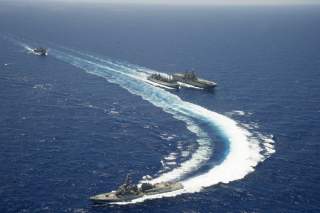China’s RIMPAC Debut: What’s in It for America?
"Despite concerns that Beijing’s participation constitutes a net loss for Washington, the U.S. can in fact derive substantial value from including China while building global maritime security partnerships."
Four, the PLAN’s inclusion is a small-but-tangible counterweight to negative depictions of the U.S. Asia-Pacific Rebalance, which many Chinese view as a scarcely disguised containment strategy. It capitalizes on China’s desire to offset its deteriorating reputation in East Asia through cooperative initiatives like RIMPAC. Moreover, as RIMPAC’s host, America is effectively providing a modest communication platform for the navies of China and its rival claimants Japan and the Philippines. China currently is embroiled in territorial disputes with seven RIMPAC invitees including Brunei, India, Indonesia, Japan, Republic of Korea, Malaysia, and the Philippines. The biannual exercise is a rare window for forward-looking engagement among all parties. China’s participation does not harm U.S. credibility, and America is using other means to assure its allies in their home waters.
Instead, RIMPAC offers a powerful comparison. In the warm waters off Hawaii, it juxtaposes America’s proactive, progressive global maritime partnerships approach with Beijing’s increasingly parochial obduracy—making it clear for all to see that China is essentially “containing itself.” Beijing’s naval neighbors will increasingly have reason to ask pointedly why the same navy that worked professionally with them off Honolulu is harassing them closer to home—often in coordination with a unifying China Coast Guard whose hull numbers are projected to grow 25% over the next few years . Additionally, while critics have argued against China’s inclusion based on its assertiveness in the East and South China Seas, RIMPAC is not a region-specific exercise. As in the past, the U.S. has invited navies from five continents to the 2014 exercise. China’s participation further signals that America’s maritime posture is truly global, and that Sino-American military relations do not hinge merely on events in one region or issue domain such as the East and South China Sea disputes. Uninviting China’s Navy, as happened recently with Thai observers, would greatly undermine this perspective while playing into the hands of Beijing’s able propaganda apparatus.
Fifth, and most importantly, China’s attendance at RIMPAC benefits America’s long-term efforts to make China more accountable as a global maritime actor. Beyond the immediate benefits to the U.S. Navy outlined above, inviting China (and not cancelling its invitation despite Beijing’s growing assertiveness since 2012) is symbolically significant. America wants China to “carry its weight” in the realm of global maritime governance despite tensions in East Asia. Other states will share this desire more explicitly if America’s ability to police the world’s oceans faces growing constraints in coming years. Despite its great power aspirations, China remains a “passive power” that has yet to embrace the role and responsibilities of a world-class power. Moreover, for now China’s economic and military might does not translate into proportional amounts of real influence in world affairs.
As the Gulf of Aden experience has demonstrated, encouraging China to participate more actively in global governance by integrating it into existing maritime governance mechanisms is realistic. However, it requires the efforts of multiple states as well as substantial flexibility and retrofitting. American officials have acknowledged inevitable friction in the bilateral relationship, but rightly dismiss the notion that it must preclude pragmatic cooperation between the world’s two largest navies and their partners to secure global sea lines of communication (SLOC), combat nontraditional threats such as natural disasters, piracy, terrorism, and other forms of maritime crime. After taking a commanding lead in securing the world’s oceans throughout the post-Cold War era, Washington is gradually setting precedents that will press Beijing to increasingly provide public goods commensurate with its naval abilities and ambition. RIMPAC 2014 suggests that American naval leaders are pursuing an unspoken strategy of “competitive coexistence” wherein unavoidable tension does not preclude pragmatic engagement designed towards balancing states’ contributions to international security and their abilities and aspirations.
And so, the U.S. has wisely, warily welcomed China to RIMPAC. It should continue to strive for competitive coexistence with China on the high seas by encouraging Chinese maritime public goods provision even while opposing its bullying behavior in the East and South China Seas. Fortunately, early signals suggest that China’s 2014 invitation will not be its last. It would be shortsighted to fixate on “who wins” at RIMPAC 2014, which is merely one event in the broad and developing waterfront of Sino-American relations. U.S. policy objectives vis-à-vis China and international security are far larger and deeper than a biannual exercise. Desires on the part of America and other states for greater Chinese contributions to global maritime security constitute a rising tide even as problematic whirlpools remain.
Andrew S. Erickson, an associate professor at the U.S. Naval War College, blogs at www.andrewerickson.com.
Austin M. Strange is a Ph.D. student at Harvard University.
Image: Flickr/U.S. Navy/CC by 2.0

